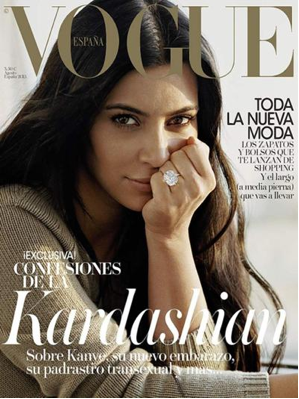
Kim Kardashian West is in the limelight again for one of her magazine cover appearances — but this time, she’s fully clothed.
Who could forget about the time she tried to break the Internet with her racy Paper Magazine cover in winter 2014?
Kim K. appeared, sans (visible) makeup, on the cover of the upcoming August 2015 issue of Vogue España. According to photographer Theo Wenner, she is only wearing “moisturizer and a touch of lip balm.”
Showing off her pregnancy glow, Kim K. also appears in pajamas (and her underwear). On her Twitter account, she displays photos and outtakes from her Vogue shoot, tagging them as #KimNoFilter.
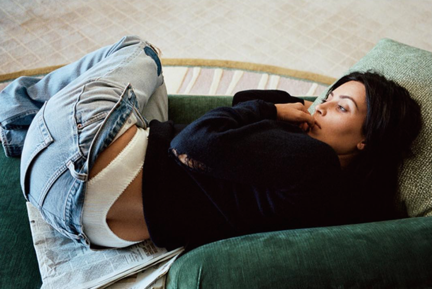
In a larger context, Kardashian West’s cover appearance doesn’t just send a message about makeup (or lack thereof) — it also sends one about the pregnant body. The reality star has been one of many celebrities who can be credited with normalizing the pregnant body as sexy and chic. The August Vogue España cover juxtaposes the cult of motherhood with the cult of the celebrity, a space so expertly occupied by Kardashian West. And in its own way, it perpetuates the established ideal of the “sexy mom.”
Pregnancy hasn’t always been so popular. Up until the 1990s, to be “with child” was considered shameful, and women went to great lengths to conceal their “condition.” In addition to trying to avoid discrimination in the workplace, women hid their pregnancies for as long as possible. Any

indication of a woman possessing sexuality was seen as shameful, especially if she was pregnant — the ultimate proof that she was sexually active (even if she was married). Fashion trends reflected this cultural view, exemplified by tent-shaped dresses and unflattering maternity muumuus.
Up until the 1980s, pregnant bodies were deliberately excluded from magazines. Then, American actress Jaclyn Smith appeared on the February 1982 cover of Time magazine, and her pregnant body took center stage. Though this cover was revolutionary, Smith’s prim and proper portrait appears in stark contrast to the carefully sexualized, bare baby bump spreads of celebrities like Jessica Simpson.
However, what is arguably the most iconic magazine cover featuring a pregnant celebrity appeared in August 1991, when Demi Moore posed nude on the cover of Vanity Fair, adorned in diamonds and clutching her bare belly. Feminist scholars cling to this image because a seven-month-pregnant Moore “stands firmly outside medical representations that treat pregnancy as pathology.” Her cover appearance signified a profound shift in cultural norms and taboos that had for years surrounded the visual and cultural representation of the pregnant body.
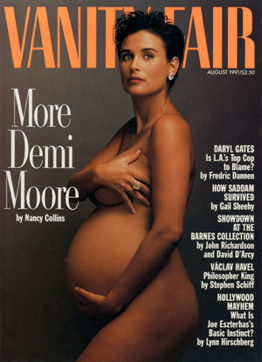
Pregnant bodies had been largely absent from mainstream media until this groundbreaking cover. At the time of its release, it was estimated that more than 100 million people had seen Moore’s naked and pregnant body on Vanity Fair. Seen as radical for its time, the “More Demi Moore” cover was the brainchild of Tina Brown, the magazine’s intense and often controversial ex-editor. Famous celebrity photographer Annie Leibovitz brought Brown’s vision for the cover to life. Esquire art director George Lois subsequently hailed the iconic cover as a symbol of female empowerment.
In today’s media, we can see a shift away from the culture of shame, as well as its lingering traces. Popular reality television shows such as Teen Mom and 16 & Pregnant, as well as the drama series The Secret Life of the American Teenager, ushered in a new era of modern motherhood. By emphasizing the multiplicity of motherhood and what it means to self-identify as a mother, these shows displayed a sort of nonchalant acceptance of things that would’ve been unimaginable to discuss on TV half a century ago: female pleasure, sexual encounters out of wedlock, abortion, and mental health issues such as postpartum depression.
Some shows, like The Secret Life of the American Teenager, contained didactic and cautionary messages for sexually active teens, whereas shows like Teen Mom have been criticized for their portrayal of pregnancy as glamorous, fun, and commercially profitable. Curiously, shows like these aired at a time when teen pregnancy was in decline. According to CDC data, births to teen mothers have been dropping since 1991 — a statistic that is now at an all-time low.

In keeping with the media’s trend toward discussing motherhood more openly, fashion trends have shifted so profoundly that women can proudly show off their “baby bumps” in body-hugging attire from streetwear to yoga outfits. Since the rise of celebrity journalism in the 1970s and ’80s, media coverage about celebrity steadily increased. By the mid-2000s, maternity became fully commodified, and “the bump” was just another accessory and status symbol to aspire to.
Kardashian West has certainly played an important role in the discourse surrounding the pregnant body, as her fans and the tabloid media surveys her every move, making very public note of her weight gains and losses, and speculating about all aspects of her pregnancy.
For a woman who arguably brought contouring into the mainstream, appearing makeup-less on a magazine cover sends an important message, regardless of how you feel about the reality TV star. As a body image researcher, it would be easy for me to say that her latest cover represents body positivity, but that is too simplistic. She is still pandering to a buying audience obsessed with her every move. And, lest we forget, the woman has more Twitter followers than Oprah.
Her glamorous pregnancy is an ancillary aspect of her Vogue appearance, unlike other times she’s posed for fashion publications like Carine Roitfeld’s CR Fashion Book, in which she is shown looking (very) visibly pregnant.
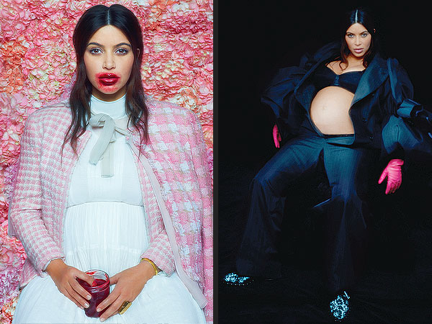
Unfortunately, with or without makeup, Kardashian West proves the pregnant body is still hypersexualized in entertainment, tabloid, and fashion publications. Culturally, it’s become the norm to engage in the widespread surveillance and commercialization of these bodies. Popular entertainment media such as People magazine, InTouch, and US Weekly have capitalized on this trend by publishing article after article about the states of pre- and post-baby celebrity physiques. People has even devoted an entire section on their website to maternity style. Society has officially made way for the marketable image of the sexy mom-to-be.
Yet this public scrutiny is also a new form of shaming. Tabloid websites not only have entire sections devoted to maternity style and “bump watches,” but also dissect which celebrities could be pregnant and which are just sporting an epic “food” or “burrito” baby.

Despite Kim K.’s barefaced photo shoot, she still looks flawless, which doesn’t exactly paint a realistic picture of maternity in general. It fails to show what the average woman deals with in her first couple trimesters, a time riddled with hormonal changes, discomfort, skin and body changes, and potential health issues. The media typically glosses over these real-life issues and glamorizes celebrity pregnancy like an enviable accessory.
In terms of body image, we’ve seen unattainable standards perpetuated by coverage of the perfectly fit “post-baby body,” in which celebrities seem to seamlessly bounce back to their pre-baby weight months if not weeks after giving birth. More recently, #MomBod delivered a dose of realness by calling these unrealistic standards into question (although not until #DadBod had gone viral first.)

The “post-baby body” sets us up to strive for deceptive ideals of new motherhood and the potentially harmful body image issues that come with that. Let’s not forget that stars have personal chefs and nannies to take care of their newborns while they spend hours a day working out with their personal trainers.
Despite its obvious commercialized value, Kardashian West’s Vogue España photos give readers an intimate glimpse into her world. She is stripped down, and there is an air of vulnerability mixed with a down-to-earth quality — a bit departure from her usual guarded, ultra-glam paparazzi photos. While Kardashian West’s cover shoot is not a perfect demonstration of body positivity and the pregnant body, it’s not a stretch to call this representation of normalized pregnancy as a step in the right direction.
And as long as people continue to question the media’s portrayals of pregnant women and take to social media to engage critically and express concerns, I’d say we’re making progress on many levels.
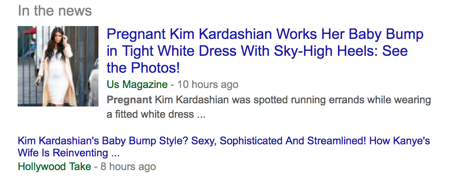
2 thoughts on “The Evolution of Pregnancy: From Shame to Post-baby Bodies and Kim Kardashian West”